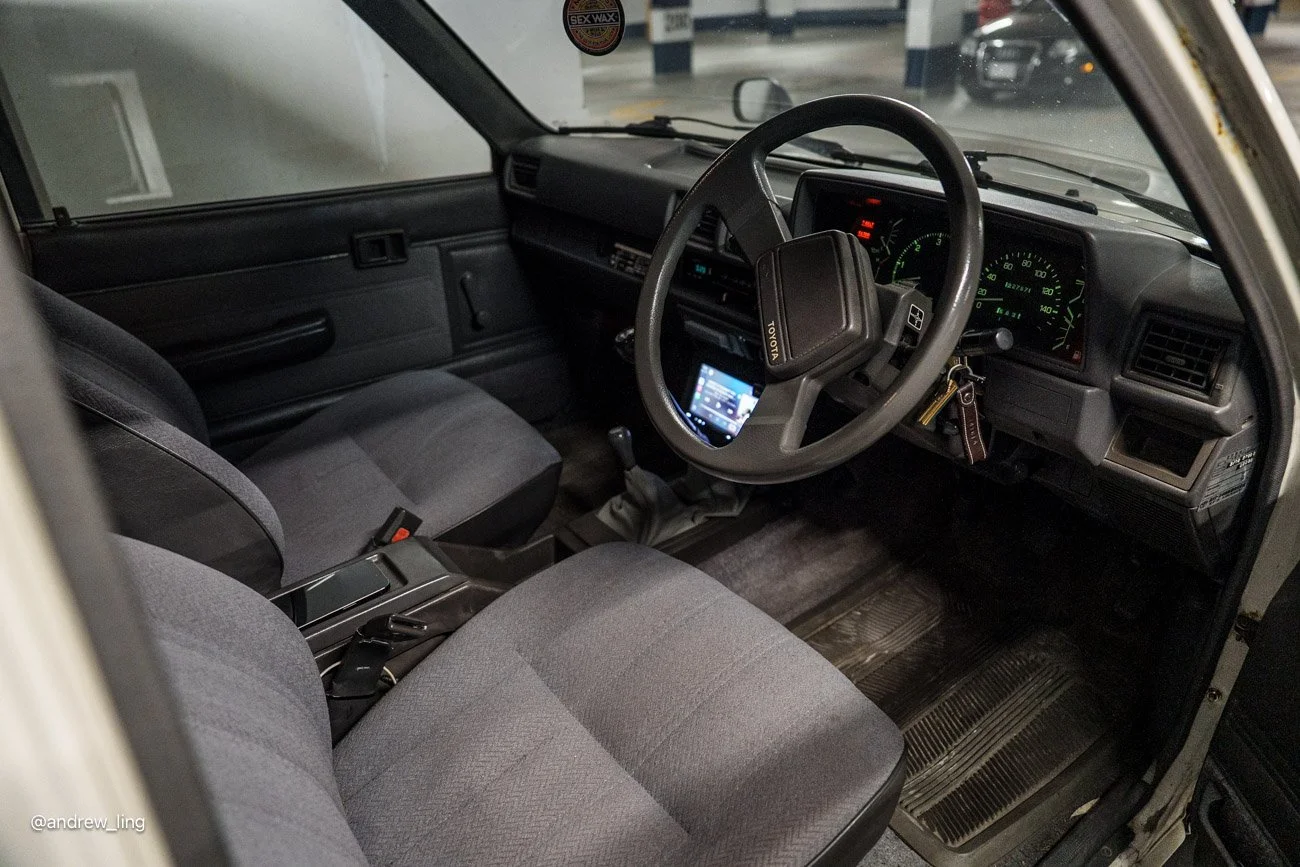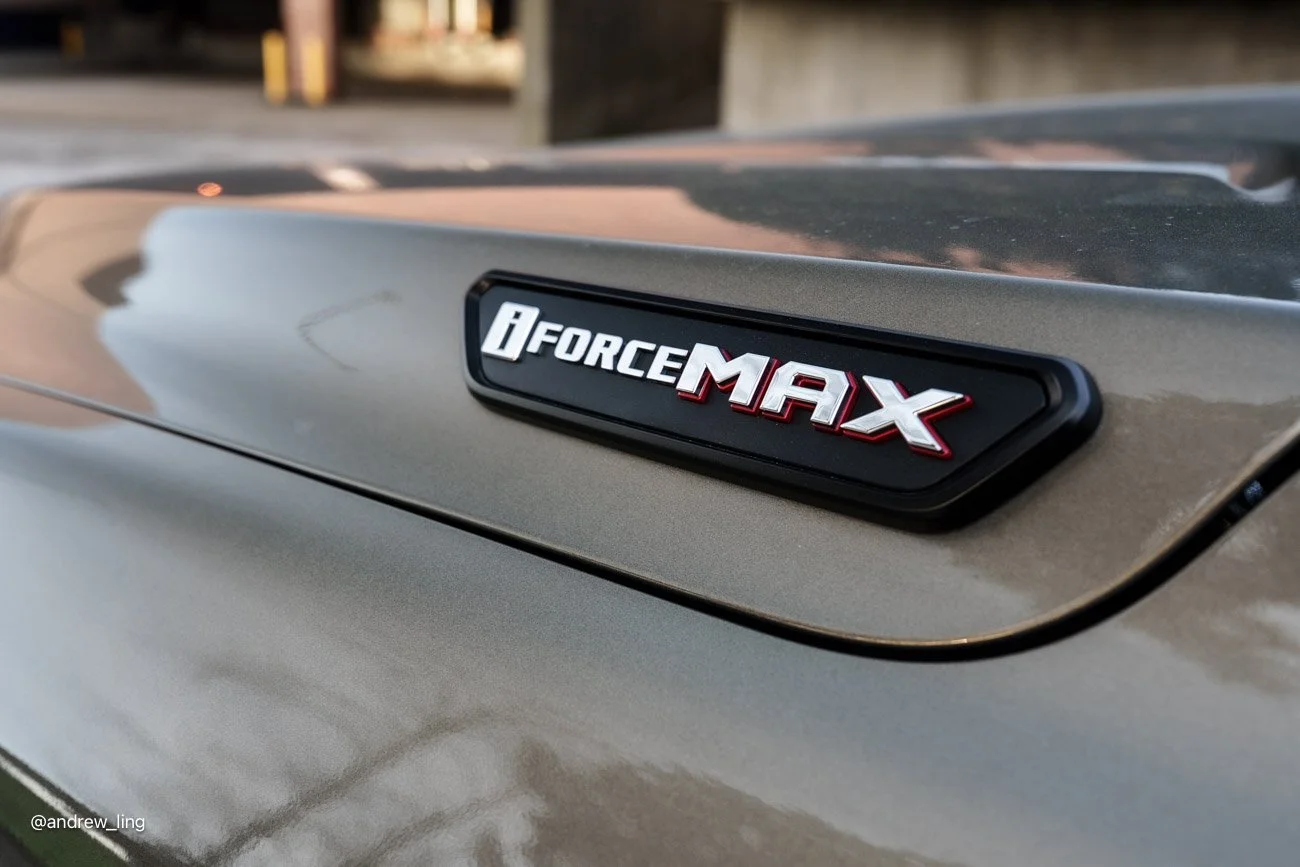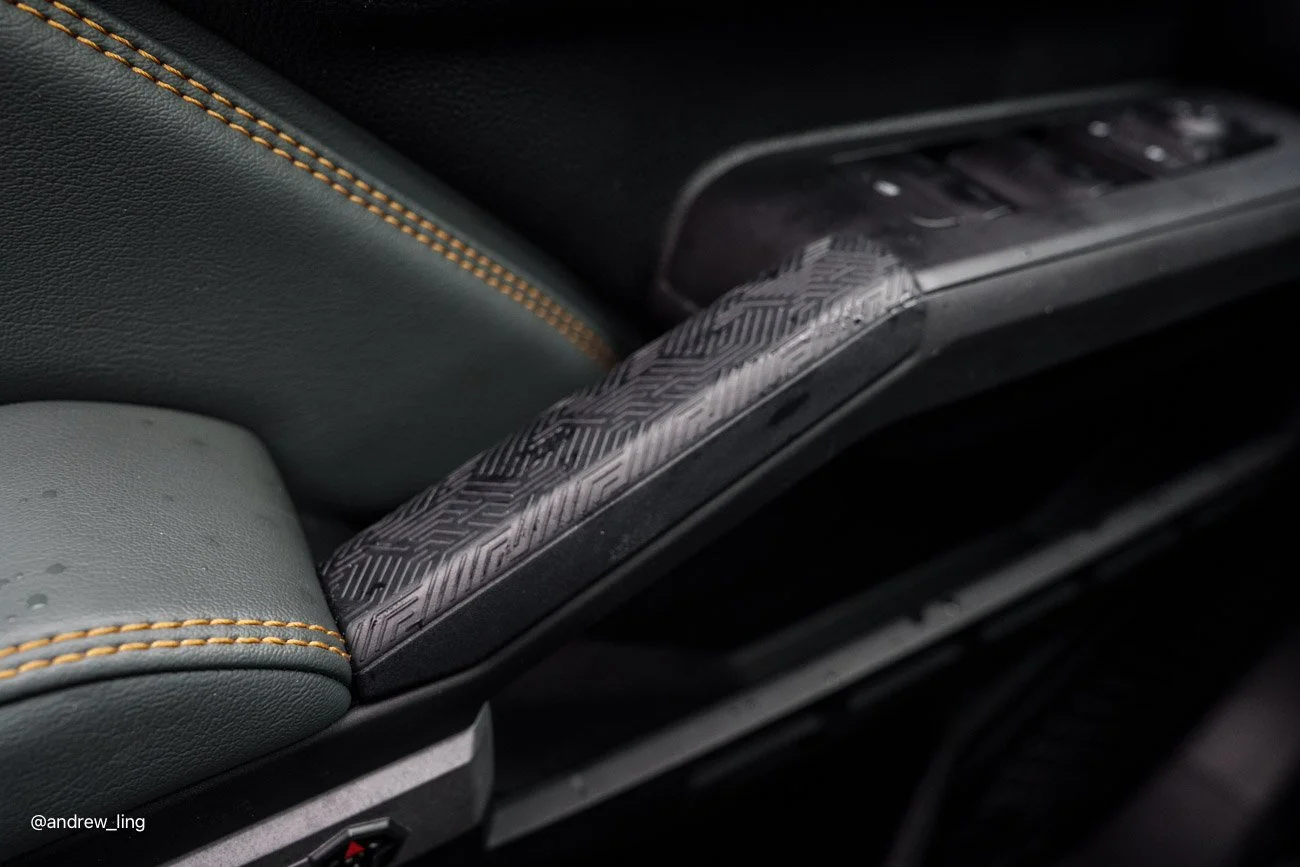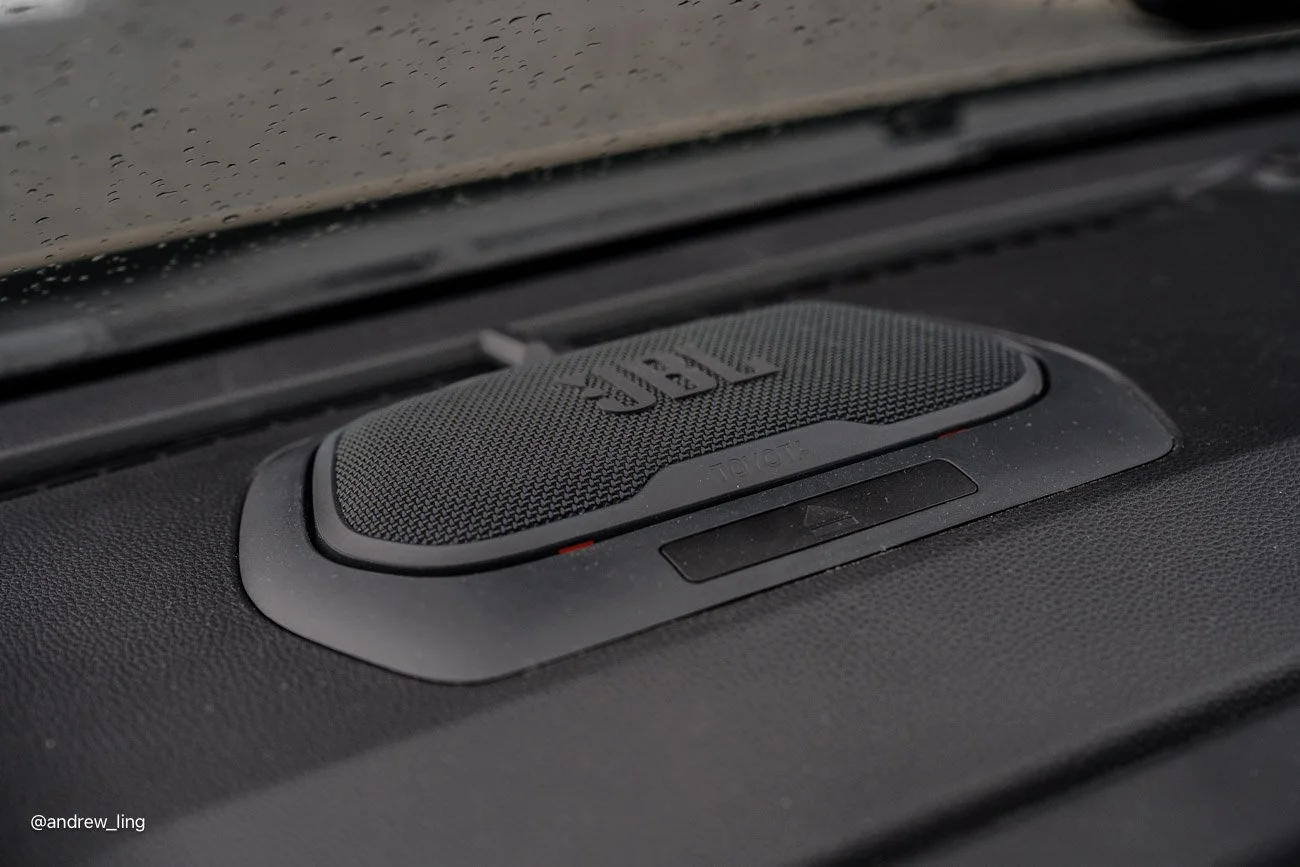2025 Toyota Tacoma Trailhunter
In the underground parkade of my office, the past pulled up beside the future.
I was returning to the 2025 Toyota Tacoma Trailhunter I’d been testing all week when a rare sight caught my eye: a diesel, right-hand-drive Toyota Hilux in pristine condition. A four-door configuration never sold in Canada. A manual transmission. Skinny steel wheels. No frills—just function. The owner, who works in the building, explained that it had started its life in Japan, been exported to either Australia or New Zealand, and eventually made its way here to British Columbia.
Likely a late 1980s or early 1990s LN106 or LN107 Hilux, the truck was small, rugged, and full of character. Its cab-forward stance, utilitarian steel bumpers, and leaf-spring suspension made it feel like a machine from another era. But parked next to the Trailhunter, the connection was unmistakable.
Despite a 30-plus year gap, both trucks carried the same purposeful aura. The Hilux might be slower, louder, and more bare-bones, but it radiated the same confidence and resilience that define Toyota’s reputation in remote corners of the world. It felt like the Trailhunter’s spiritual grandfather—grizzled and analog, compared to the tech-savvy, torque-rich grandchild beside it.
Seeing them side by side was more than a visual contrast. It was a reminder that while technology, size, and expectations have all evolved, the heart of Toyota’s mid-size pickup philosophy remains the same. Durable. Practical. Adventurous.
With that mindset, I climbed into the Trailhunter, fired up its hybrid powertrain, and pulled out of the garage. The review ahead would explore just how much of that legacy the new Tacoma had kept—and where it dared to go further.
What is the Tacoma Trailhunter?
The Tacoma has always been a name you could trust: rugged, dependable, and ready for whatever lies beyond the edge of the pavement. For decades, it’s been the mid-size pickup of choice for hikers, contractors, and everyone in between. But the 2025 Tacoma Trailhunter is something different. Something bolder. Toyota hasn’t just updated its best-seller. With the Trailhunter, they’ve purpose built an overland-ready truck right from the factory. No need for aftermarket suspension lifts or bed racks. This one comes prepped.
My test vehicle, fitted with the longer 6-foot bed, felt like a gear-hauler’s dream. It’s a strong statement of intent: Toyota is taking the overlanding community seriously. With factory installed ARB bumpers, Old Man Emu suspension, and ditch lights embedded into the bed sides, this isn’t just a cosmetic exercise. It’s ready to work.
But in Canada—where terrain and climate can throw curveballs year-round—the Trailhunter also had to prove its mettle beyond Instagram-ready photoshoots. Over the course of a week filled with real world driving, it did exactly that.
What’s New for 2025?
The entire Tacoma lineup has been redesigned, and the Trailhunter trim introduces a new tier of adventure-focused utility. It fits between the more common TRD Off-Road and the highly aggressive TRD Pro in the hierarchy, but what sets it apart is its turnkey off road build philosophy.
Where the TRD Pro leans into Baja-style performance with high speed desert running capabilities and sporty tuning, the Trailhunter feels like it was developed in the backcountry, not the racetrack. That distinction was highlighted in recent suspension tests by Car and Driver, which found that the Trailhunter’s Old Man Emu shocks and tuned dampers offered superior composure and articulation over uneven terrain, even compared to the more expensive TRD Pro.
Also new is the i-FORCE MAX hybrid powertrain, pairing a 2.4-litre turbocharged four-cylinder with an electric motor for a combined output of 326 horsepower and 465 lb-ft of torque. It's worth noting that this hybrid isn’t primarily about saving fuel. The system is tuned to deliver instant low-end torque, improving towing, trail control, and throttle responsiveness. Think of it as acting more like an electric torque booster than a traditional hybrid system.
Exterior Styling
The Trailhunter wears its intentions on its sleeve. It’s tall, confident, and purposefully rugged. There’s a muscular squareness to the silhouette that echoes vintage Toyota trucks, but modern detailing—like LED lighting and bronze badging—gives it contemporary polish.
The ARB bumpers front and rear aren’t just aesthetic. They’re winch-capable, trail-tough, and come equipped with red-painted ARB recovery hooks that are both functional and visually striking. Whether you’re pulling a buddy out of a snowbank or just adding peace of mind on a muddy trail, these hooks speak volumes about the truck’s off road credibility.
The bed-side ditch lights are another functional flourish. Mounted just behind the cab, they illuminate the truck’s flanks when crawling through forest trails or staging at a campsite in the dark. The stamped Trailhunter tailgate, black fender flares, and beadlock-style wheels complete the package.
From nearly every angle, the Trailhunter looks more like a custom SEMA build than a showroom truck—and yet, here it is, factory backed and fully warrantied.
Integrated Light Bar and Signature Lighting
One of the Trailhunter’s most striking visual cues is its integrated LED light bar, seamlessly embedded in the heritage-style TOYOTA grille. This isn’t an aftermarket add-on. It’s factory equipped, solidly mounted, and tuned to provide a wide angle flood pattern for trail visibility at night or during sudden weather shifts.
The light bar is flanked by signature LED daytime running lights, with a split beam headlamp design that helps set the Trailhunter apart from the rest of the Tacoma lineup. It’s not just for looks. This lighting setup casts a broad, usable pattern—perfect for picking your way through wooded terrain or illuminating a snow covered trailhead.
Where darkness and storms often go hand in hand, it feels like a proper tool rather than a gimmick. Paired with the bed side ditch lights, it completes a lighting package that is genuinely practical for real trail work.
Drivetrain and Off-Road Systems
One key element of the Trailhunter's off road configuration is its part-time four-wheel drive system with a two-speed transfer case. This setup gives drivers the flexibility to select between 2WD, 4WD High, and 4WD Low, with a locking rear differential available for navigating slippery or uneven terrain.
While this drivetrain is time-tested and capable, it’s worth noting that it lacks the full-time or automatic 4WD systems offered by some rivals. Competitors like the Ford Ranger Raptor, Chevy Colorado ZR2, and GMC Canyon AT4X all provide the convenience of full-time 4WD or automatic engagement, which allows for more consistent stability on wet or variable surfaces.
As someone who lives in Vancouver and deals with relentless fall rain and surprise ice patches, I found myself wishing for that always-on traction in daily use. Toyota’s system is traditional and effective, but because it can only be engaged on loose surfaces, it demands more input and attention in changeable road conditions. In urban and mixed-use Canadian settings, a more seamless AWD or full-time 4WD system might better match the lifestyle of year-round adventurers.
That said, when used as intended—on gravel, mud, snow, and rocks—the Trailhunter’s traction tools work brilliantly. It features an electronically controlled locking rear differential, Multi-Terrain Select, and Crawl Control, all of which contribute to confident low speed off road handling.
By comparison, the TRD Pro gets additional high-performance dampers and slightly different tuning but shares many of the same drivetrain fundamentals. Where the TRD Pro prioritizes higher-speed desert tuning, the Trailhunter's focus on torque-rich crawling and low speed articulation makes it better suited for Canadian terrain: steep logging roads, icy cottage access trails, and sudden snowfall.
Cabin Technology and Interior
Inside, the Trailhunter balances utilitarian toughness with clever features and improved ergonomics. The cabin materials feel durable but not cheap. You’ll find rubberized knobs and grips, intuitive physical buttons, and an array of clever storage options.
The seats are finished in Black with Copper-Coloured Accents, lending a distinctive contrast that’s more adventurous than refined. Heated front seats, a heated steering wheel, and dual-zone climate control make it genuinely livable in harsh Canadian winters.
But the standout here is the tech suite. The 14-inch touchscreen dominates the centre stack and features a highly responsive interface with crisp graphics. Wireless Apple CarPlay and Android Auto are standard, and the new infotainment system feels like a substantial leap over the outgoing Tacoma's dated setup. Touch input is snappy, and the menus are logically arranged.
Where Toyota really impressed me was the 360-degree surround-view camera system. It’s not just useful, it’s outstanding. The image quality is among the best I’ve seen in a pickup truck, with multiple angles including a top-down view that helps when parking in tight spaces or lining up to a trailer. The bed-mounted camera also gives you a live view of your cargo.
Add to that the JBL audio system with removable Bluetooth speaker, and you’ve got a space that feels ready for both city commutes and backcountry basecamps.
Rear visibility is excellent thanks to large side mirrors and the relatively upright cabin layout. Legroom in the second row is fine for only average-sized adults on short hauls, and the upright seatback is not particularly comfortable for longer rides. Competitors from Ford and GM offer more rear space, something that might be of consideration if you’re using the Tacoma as a family vehicle.
Under the Hood
Powering the Trailhunter is Toyota’s i-FORCE MAX hybrid engine, delivering a combined 326 horsepower and 465 lb-ft of torque. That’s a massive bump over previous V6-powered Tacomas and puts this truck near the top of the segment in terms of grunt.
As I mentioned earlier, this hybrid system is less about conserving fuel and more about enhancing capability. The electric motor’s instant torque dramatically improves low-speed responsiveness and makes towing or crawling up steep grades feel effortless. The torque arrives early and sticks around longer, smoothing out shifts and reducing strain on the transmission.
In mixed driving and careful throttle application, II averaged around 12.7 L/100 km, which isn’t bad given the Trailhunter’s weight, size, and aggressive tires. But make no mistake, this is a performance-oriented hybrid. If you’re looking to save fuel, the Prius still exists.
How Does It Drive?
Driving the Trailhunter in a variety of settings—from downtown Vancouver’s rainy side streets to snowy highway stretches on the Sea-to-Sky—revealed a truck that’s more comfortable and composed than I expected.
At low speeds, the electric boost helps smooth out throttle input. You’re never waiting for a downshift or worrying about turbo lag. On the highway, it feels stable and surprisingly refined, with less body-on-frame jostle than older Tacomas.
Steering is well weighted, if not exactly sports-car precise. But visibility is strong, and the seating position gives you an excellent view of your surroundings. I found it easy to thread through busy ferry terminal lanes and downtown parkades, though the 6-foot bed does require some spatial awareness especially when parking.
On gravel or snow, the Trailhunter truly shines. The Old Man Emu suspension keeps things settled even when one wheel is in the air. The Multi-Terrain Select system lets you dial in traction for mud, rocks, sand, or snow, while the Crawl Control essentially acts as off road cruise control.
This truck never once felt overwhelmed, even on steep hills or icy side roads in the Tri-Cities.
Additional TechDriven-Approved Features
360-degree camera system: One of the best I’ve seen in this segment. Clean visuals, intuitive controls, and multiple views make trail navigation and tight parking a breeze.
Bed-mounted camera: Provides live feedback on your cargo load—great for towing, hauling, or simply making sure your bikes haven’t tipped over.
Trailer Brake Controller: Fully integrated and easy to use. Rated to tow up to 6,000 pounds, the Trailhunter is a true weekend warrior.
2,400W inverter in the bed: It can power a coffee maker, tools, and much more
Integrated bed mounted air pump
ARB recovery hooks (red): A small but meaningful touch. They’re visible, rugged, and add to the visual drama at the rear.
Ditch lights and snorkel: They’re not just cosmetic, they add capability, not just style.
Final Thoughts
The 2025 Toyota Tacoma Trailhunter isn’t just a trim level—it’s a statement. It’s for people who actually plan to leave the pavement and want their truck to be ready from day one. No lift kits, no guessing about compatibility, no warranty headaches.
It’s not trying to be a luxury truck, though it doesn’t skimp on the comforts. It’s also not trying to be a high-speed desert runner like the TRD Pro. Instead, it’s carving out its own niche as a go-anywhere, live-anywhere rig, perfect for Canadian adventurers.
It’s big, bold, and expensive. But in return, you get a factory-built overlanding machine with power, tech, and toughness baked in. For the right buyer, that’s not just acceptable, it’s ideal and would be my choice over the Tacoma TRD Pro.
5 Key Takeaways
The i-FORCE MAX hybrid system delivers torque-rich performance designed for power, not just fuel savings.
Old Man Emu suspension and ARB bumpers give it real trail credibility right out of the box.
Cabin tech has been vastly upgraded, highlighted by a crisp 14-inch screen and excellent 360-degree camera.
A 6-foot bed, snorkel, and bed-side ditch lights make it uniquely ready for Canadian adventures.
For drivers who actually use their truck’s full capability, the Trailhunter might be the most complete Tacoma yet.




























































